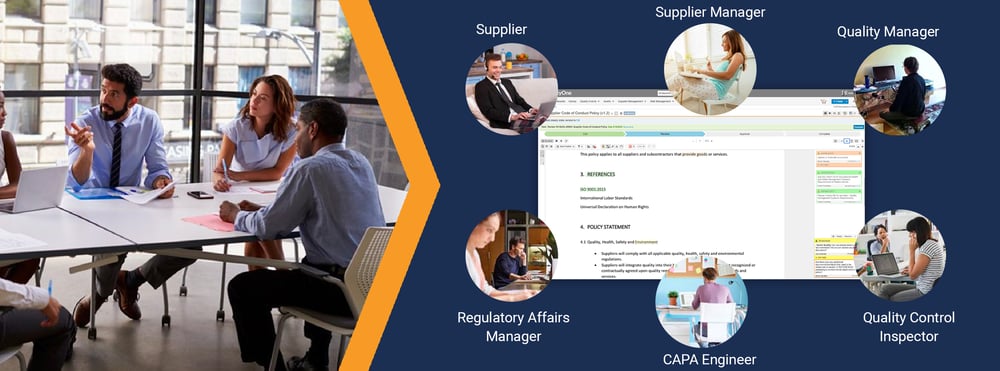For the last 20 years the move to cloud software has been under the rhetoric of “it’s not if, it’s when.” I believe we'll look back at 2020 as the year “when” was replaced with “NOW”.
In March of this year, the world abruptly changed as the Covid-19 pandemic swept the globe. The last time we experienced a global pandemic of this magnitude, there was no such thing as a computer. But today, not only are computer systems pervasive, technology has advanced so fast that its role has shifted from supporting our society’s evolution to driving our evolution.
Let me guess, you are reading this on a computer, tablet, or smartphone? And I’m going to assume not as a document you got attached to an email? Times have changed.
How Prepared Were Businesses to Adapt to Disruption?
In response to the Covid-19 pandemic, work previously done face to face has been forced into real time remote collaboration as companies focus on business continuity. Leaders are also adapting standard processes to enable their companies to thrive in this so-called “new normal”. Connecting people, information and processes has never been more urgent. Those connections must be easier, more flexible, more secure, and more accessible than ever before. Cloud software is equipped to do just that.

These circumstances have laid bare which companies have already invested in modern cloud-based solutions for their workforces and across their supply chains, and the 65% that are still getting by with a patchwork of email, spreadsheets, and legacy software.
So it’s no surprise that the companies that are struggling to achieve business continuity from their now largely remote workforces have shifted “cloud-based software” to the top of their priority list.
Through this Q&A, I’ll explore some of the most common questions about “the cloud” and its value in these turbulent times and beyond.
1) What really is Cloud software (in a nutshell)?
Cloud software, also known as multi-tenant cloud or Software as a Service (SaaS), involves multiple customers leveraging a single, scalable, and always-current version of software or infrastructure, which is managed and hosted by the software vendor.Much like systems used to separate bank accounts or medical records, multi-tenant cloud uses virtual partitioning (think firewalls) to securely segregate customer’s data, configurations, and customizations. Each customer’s configuration or customizations are their own. In other words, each customer (a.k.a. tenant) shares computing resources, but each “tenant” is autonomous and remains invisible to other tenants.
Cloud software has been replacing the “installed” or “on-premise” software from the prior generation for almost 20 years now. Just like streaming music has replaced the compact disc….or to be more accurate with the comparison, the cassette player.
2) How does Cloud software help productivity?
Productivity has many enemies working against it. At a company, team, or individual level. I will focus on two of productivity’s key nemeses and how Cloud helps.
The first nemesis is making mistakes due to outdated or missing information. People conduct business operations and make decisions every day based on information they have or instructions they are following. If that information or instructions are not accurate, mistakes are made. In addition to the impact of the mistake, there is also lost time to correct that mistake. With cloud software, a definitive source of information is collected, enriched, and shared across the enterprise in real time regardless of where people are or the hardware they are using.
The second nemesis is distance. Distance between people, sure, that’s obvious. Cloud shrinks the world so that we can operate the same regardless of if we are in the same room or in different countries. Be it the day-to-day collaboration, crunching numbers, or improving a process, cloud software brings the where, why, when, how, and by who altogether in a single application that can be accessed anywhere and on any device. A trusted single source of truth matters.
Need proof? Would you trust a document or spreadsheet you received in an email three months ago to make a critical decision or conduct an important task? Or could something have changed since then?
3) How does Cloud software make operations and connecting easier?
For this one, I’ll draw upon the fact that social distancing suddenly became a mandate. Supply chains and manufacturing operations have to keep going, people still need to interact with customers and coworkers, and timely information is critically important to get as well as give. The adjustments organizations needed to make to implement social distancing measures would have been far more disruptive with “legacy” tools and systems, such as:
- Installing or upgrading hardware
- Sending out technicians or shipping files (physically or via email attachments)
- Struggling with an application interface that drives people to not use the software
How is Cloud different? In short, it leverages the latest and greatest technical innovations instead of applying bandage after bandage to old software paradigms.
Need proof? When Covid-19 hit, clinical researchers needed to rapidly mobilize to test existing and new medications to see if it could help with a cure or vaccine. At the same time, for safety reasons those researches were not able to monitor patients the traditional way. Within weeks, Veeva was able to quickly innovate and offer a remote monitoring solution to clinical research sites.
4) Is Cloud software secure?
Cloud software providers know that security and scalability are table stakes for success. Their customers include governments, banks, pharmaceutical companies, and other industries that need to protect highly sensitive information. If a software vendor has security or scale issues, they are finished!Reputable cloud software vendors apply greater expertise, investments, and resources to ensure the infrastructure and their customer’s data is as secure as possible. And with multi-tenant Cloud, each investment benefits every customer automatically. The ROI is massive and greater ROI leads to larger and more frequent investments. So when new innovations in security become available, your Cloud software vendor is more inclined to make those investments and you get the benefit. This is also why security investments made by a reputable Cloud software provider surpass security investments a non-software company can make.
Need proof? Do you have your money at a bank or is it under your mattress or a safe in the closet?
5) How does Cloud software provide greater flexibility?
Better flexibility and agility tend to lead to accelerating innovation. Without innovation, companies become more vulnerable, less efficient and lose competitive ground. Without software innovation, your applications may not deliver the productivity gains that are needed every year to stay competitive.
As we were reminded in early 2020, change is not always predictable, but it certainly always is coming. Flexibility is how you support or enable change by becoming more agile. If you don’t have agility, you fall behind as the world continues to change….at a faster pace than ever.
Multi-tenant cloud software is an appreciating asset. New capabilities are included with your subscription and are typically released two to three times a year. In each of those releases, customers are getting continuous improvement to point-and-click configuration tools to tailor the application; the page layouts, permissions, workflows, etc.
Need proof? A change in a Cloud application can be done in minutes instead of weeks or months of effort done by software developers. Which would you prefer?
6) Is all Cloud software the same?
No. At a high level there is multi-tenant cloud and private cloud. A private cloud software delivery model provides each customer with their own instance of software. The key difference compared to on-premise software (software hosted and maintained on your company’s premises by your IT department) is that with private cloud, the software vendor hosts the supporting infrastructure in its data center or on a cloud infrastructure (ex. Amazon Web Services, Microsoft Azure).
Despite appearances, private cloud is closer to on-premise than it is to multi-tenant cloud. In many cases, private cloud providers are merely disguising on-premise software with a cloud delivery model.
Need proof? Did you have a better experience with Netflix when they mailed you DVDs or with its current cloud-based streaming service?
7) Is Cloud software more expensive?
Most cloud software is offered via a subscription license model where customers pay for the software, similar to a Netflix subscription. So when it comes to evaluating Total Cost of Ownership (TCO) it is important to understand different software delivery models (Cloud vs on-premise software) shift costs between licenses, maintenance, upgrades, resources, and other areas. This lack of parallelism makes it difficult to establish accurate cost comparisons.
If you are solely comparing license costs, Cloud software will appear more expensive. But if you add up all the direct and indirect costs across traditional installed software and Cloud software, not only will Cloud software carry a lower TCO, it will deliver a higher ROI and greater cost predictability.
Need proof? A company could buy on-premise software for say, a one time perpetual license fee of $4000 per user. Or it could go with Cloud software for say, an annual license fee of $1500 per user. Within 3 years, the Cloud software license cost will exceed the on-premise license cost. But that is just the cost of the license. With on-premise software the hardware, storage, maintenance, upgrades, additional personnel, and higher costs to make changes all need to be factored in. Those costs add up to be higher than just the license cost. In fact in many cases, the annual maintenance and upgrade costs with on-premise are comparable or higher than the annual Cloud software subscription cost. And with Cloud software, all those maintenance, upgrade, and additional indirect costs are included in the predictable license subscription.
8) How should I get started?
Take a moment to reflect on how much has changed in your organization in the past few months. Probably more than you ever imagined possible. Often it takes a crisis, or something else that drives a powerful sense of urgency, to show us what we’re capable of when we set our minds to it.
This time last year, would you have believed that LVMH could adapt its perfume factories to produce hand sanitizer in 72 hours? Or that Dyson could design and start production on a new ventilator in 10 days?
Knowing what we’re capable of, it now seems incredibly wasteful to take over a year - filled with countless meetings, demos, RFPs, and the like - to make a decision on investing in cloud software. It’s certainly not agile, which is what we all need to be in these circumstances.
So my challenge to you, no to us, is to identify an addressable piece of one of the most painful parts of your business today. Maybe it’s performing remote supplier audits to keep your employees safe and avoiding unnecessary exposure to the virus. Or how you manage product claims, if you’re looking to emphasize the health or cleanliness aspect of your product.
Whatever it is, spin up a proof of concept (POC) or pilot project to address it. Small projects have the agility to move fast, and produce quick wins that build momentum. And with cloud, if the project is successful, the work can be flipped right into a production application and scaled to meet your organizational needs.
Your organization, and your customers, are counting on you to meet this moment. Let’s get started.
--
Ready to take the next step? Check out the next chapter of our cloud software buyer's guide.
SHARE





